John Brown's Fort/Musket Factory Fire Engine House
Introduction
Text-to-speech Audio
John Brown's Fort was a U.S. Armory engine and guard-house constructed for the Musket Factory in 1847-8. It's original location was across the street where the John Brown monument now stands. In 1859, John Brown and his men used this fort to attempt to free the slaves of the area, his attempt was unsuccessful but brought national attention to the area of Harpers Ferry and raised tensions around the topic of slavery. The Engine House was repositioned here in 1968 and restored in 1976-7,
Images
John Brown's Fort
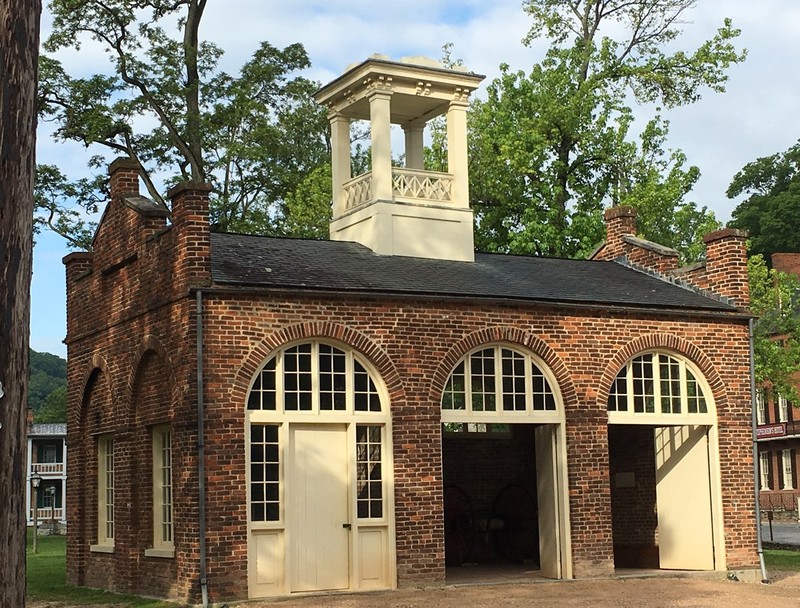
John Brown, 1859

Sketch in Frank Leslie's Illustrated Newspaper on October 29, 1859 of U.S. Marines storming the engine house against John Brown and his men.
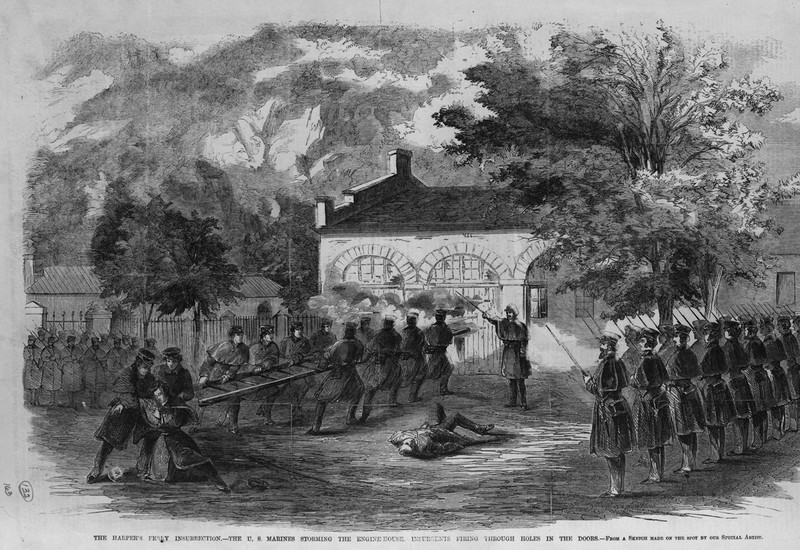
"Harper's Ferry Insurrection--Interior of the Engine-House, Just Before the Gate is Broken Down by the Storming Party--Col. Washington and His Associates As Captive, Held By Brown as Hostages." (Hostages are shown on the left of the image)
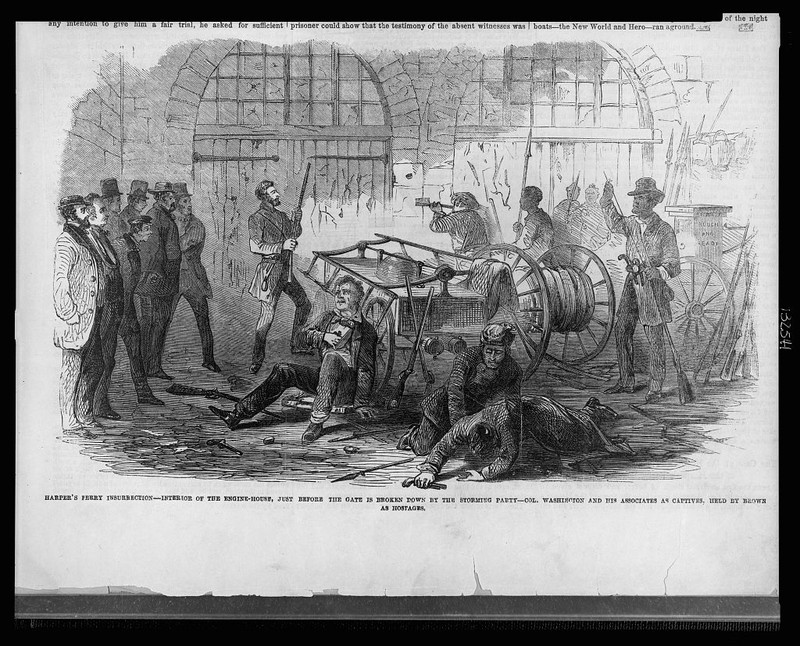
John Brown's Fort, c. 1886-89.
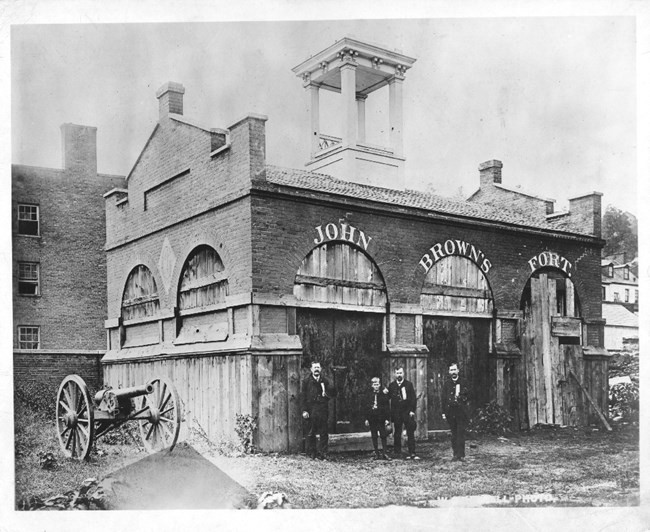
John Brown's Fort on the Murphy Farm
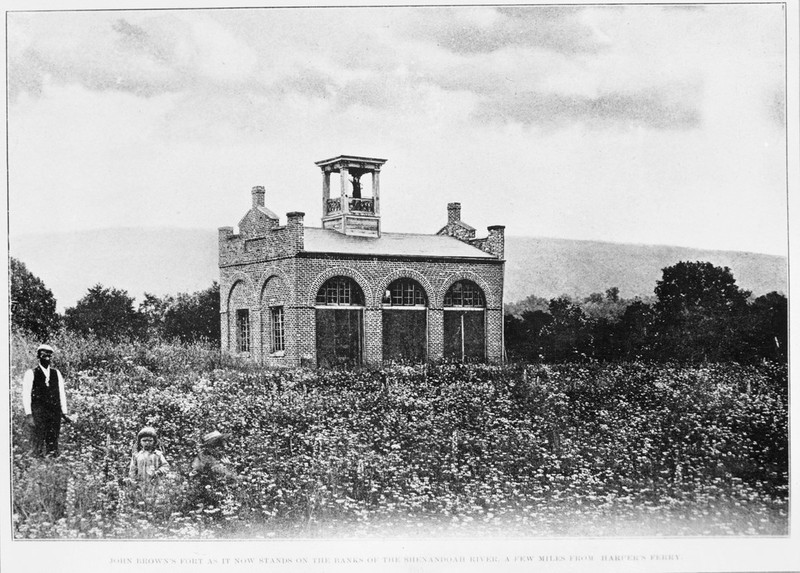
John Brown's Fort arriving back to Lower Town in 1968 to its current position.
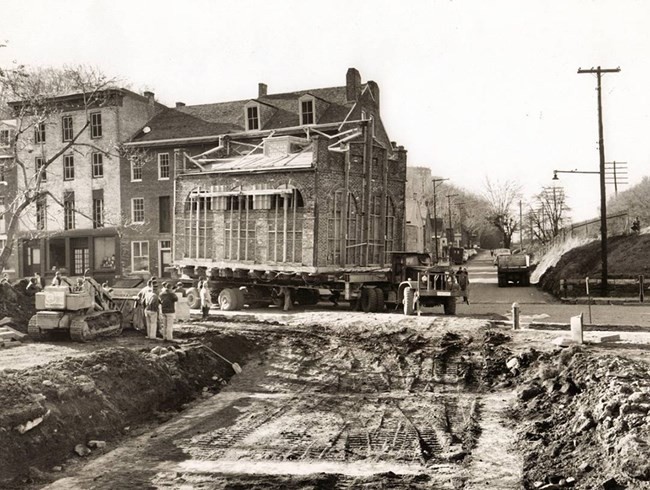
U. S. Armory fire engine and guardhouse, located near the confluence of the Potomac and Shenandoah rivers, was used by John Brown and his men during the 1859 raid to free enslaved Blacks. Exhibited in Chicago during the 1893 World’s Fair, Brown’s Fort returned and in 1909 was erected on the campus of Storer College, WV’s first African American college (1867-1955). Moved to present site in 1968.
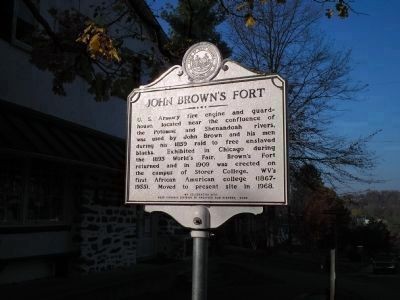
Backstory and Context
Text-to-speech Audio
John Brown's Raid:
Born in Torrington, Connecticut to an abolitionist family, John Brown married twice and had a large family. He became an Underground Railroad conductor and founded the League of Gileadites, which was an organization that helped slaves escape to Canada. When he was 55 he moved to what is now Kansas and on May 24, 1856 he led a small group of men to Pottawatomie Creek and dragged five unarmed men and boys that were thought to be supporters of slavery from their homes and brutally murdered them, he then freed eleven slaves and killed slave owners in Missouri.
After raiding Kansas and Missouri, Brown raised money throughout New England so he could take his efforts to the south. Brown then rented a farmhouse property just a few miles from Harpers Ferry under the alias Isaac Smith and used it to train an army of 21 men to capture the Federal Arsenal at Harpers Ferry, along with providing the local slaves with weapons under the impression that they would join him and free more slaves. However on October 16, 1859, Brown went through with the raid and was unsuccessful, the slaves of the area did not join and the raid was defeated by U.S. Marines and local militia under the instruction of Robert E. Lee, with most of Brown’s men being killed or captured.
After the raid Brown was tried quickly and found guilty for murder, inciting a slave insurrection, and treason against the state of Virginia. upon his sentence Brown made this statement: “…if it is deemed necessary that I should forfeit my life for the furtherance of the ends of justice, and mingle my blood further with the blood of my children and with the blood of millions in this slave country whose rights are disregarded by wicked, cruel, and unjust enactments--I submit; so let it be done!” Brown also stated that he wished his plans had gone “without the snapping of a gun on either side.” However, there were many guns shot and many people killed due to his actions at Harpers Ferry and Kansas. Brown left the country split, some called him a hero and some called him a villain but both sides did not support his use of violence to get the point across, Brown was hung on December 2, 1859, in what is now Charleston, WV.
A few years after Brown’s raid and execution on June 20, 1863, West Virginia voted to secede from Virginia and join the Union to fight slavery, and the first capital of West Virginia was established in Harpers Ferry. The split was a very controversial move that even President Lincoln himself had trouble deciding on if it should be a state or not but ended up approving because that gave the Union control of a lot of the railroads in the area, which played a large part in how the Union won the Civil War.
Description of the Musket Factory Engine House from the 1980 National Register of Historic Places Nomination:
Musket Factory Fire Engine House—“popularly known as ‘John Brown’s Fort’ (Musket Factory Bldg. No. 1, Park Bldg. No. 63), was moved to the east side of Arsenal Square in 1968. It is a one-story brick building, 35-1/2’ by 24’, with slate roof, copper gutters and downspouts, and a wooden cupola for a fire bell. Designed by Maj. John Symington, Armory Superintendent, it was first erected across Shenandoah Street in the Musket Factory yard in 1847-48. It contained one room for two fire engines and a guard room for the night watchmen. John Brown seized and held this building during his raid of October 16-18, 1859. In 1865 the building was in good condition and used as a Union gunpowder magazine. In 1892 it was dismantled and reassembled for exhibit as “John Brown’s Fort” at the Columbian Exhibition in Chicago. In 1895 it was retuned to Harpers Ferry where, because its original site was unavailable, it was reassembled on Alexander Murphy’s farm overlooking the Shenandoah River near Bolivar Heights. It remained there as a museum until 1910, when the trustees of Storer College acquired it and moved it to the campus on Camp Hill. It continued as a museum on that site until 1960, when the college closed and its property was acquired by the National Park Service. By now somewhat diminished in integrity, the structure arrived at its present location in 1968, was restored in 1976-77, and awaits ultimate return to its original site when that land is publicly acquired and regraded.”
Sources
American Battlefield Trust. John Brown Biography, Invalid date. Accessed October 16th 2019. https://www.battlefields.org/learn/biographies/john-brown.
HMDB. Harpers Ferry/John Browns Fort, Historical Marker Database. October 13th 2007. Accessed October 16th 2019. https://www.hmdb.org/marker.asp?marker=82777.
"National Register of Historic Places Inventory--Nomination Form: Harpers Ferry National Historical Park." Accessed August 5, 2021. http://www.wvculture.org/shpo/nr/pdf/jefferson/66000041.pdf.
"John Brown's Fort." Harpers Ferry National Historical Park. September 21, 2016. Accessed August 5, 2021. https://www.nps.gov/hafe/learn/historyculture/john-brown-fort.htm.
"John Brown (abolitionist)." Wikipedia. Accessed August 5, 2021.
"John Brown's Fort." Harpers Ferry National Historical Park. September 21, 2016. Accessed August 5, 2021. https://www.nps.gov/hafe/learn/historyculture/john-brown-fort.htm.
"John Brown (abolitionist)." Wikipedia. Accessed August 5, 2021.
"John Brown's Fort." Harpers Ferry National Historical Park. September 21, 2016. Accessed August 5, 2021. https://www.nps.gov/hafe/learn/historyculture/john-brown-fort.htm.
"John Brown's Fort." Harpers Ferry National Historical Park. September 21, 2016. Accessed August 5, 2021. https://www.nps.gov/hafe/learn/historyculture/john-brown-fort.htm.
"John Brown's Fort." Harpers Ferry National Historical Park. September 21, 2016. Accessed August 5, 2021. https://www.nps.gov/hafe/learn/historyculture/john-brown-fort.htm.
HMDB. Harpers Ferry/John Browns Fort, Historical Marker Database. October 13th 2007. Accessed October 16th 2019. https://www.hmdb.org/marker.asp?marker=82777.
